Numerical Simulation of Groundwater Regulation in Arid Oasis Regions: A Case Study of the Shihezi Irrigation District, Xinjiang
Abstract
1. Introduction
2. Materials and Methods
2.1. Overview of the Study Area
2.2. Determination Method of Suitable Groundwater Level
2.2.1. Water Level Threshold for Preventing Soil Salinization
2.2.2. Suitable Groundwater Level Threshold for Industrial Production Areas
2.2.3. Water Level Threshold for Preventing Vegetation Degradation
2.2.4. Burial Depth of Water Level for Preventing Ground Subsidence
2.3. Regional Evaluation and Density Analysis
2.4. Numerical Simulation Method
3. Construction of the Numerical Model
3.1. Conceptual Model of Hydrogeological Conditions
3.1.1. Generalization of the Aquifer Structure
3.1.2. Boundary Conditions
3.1.3. Groundwater Recharge and Discharge Items
3.2. Mathematical Model of Groundwater
3.3. Spatiotemporal Discretization of Model
3.4. Hydrogeological Parameter Zoning
3.5. Model Identification and Validation
3.6. Simulation Plan
4. Results
4.1. Threshold of Suitable Groundwater Level in Shihezi Irrigation District
4.1.1. Upper Threshold of Groundwater Level
4.1.2. Lower Threshold of Groundwater Level
4.2. Comparative Analysis of Groundwater Level Evolution Trends Under Different Scenarios
4.3. Comparative Analysis of Suitable Groundwater Level Coverage Under Different Scenarios
5. Discussion
5.1. Analysis of the Advantages of Different Regulatory Schemes
5.2. Influence of Different Schemes on the Appropriate Groundwater Level Coverage
6. Conclusions
- (1)
- Considering the prevention of vegetation degradation, the groundwater table depth for preventing land subsidence, and the safe water level that does not cause soil salinization and ensures the safety of construction projects and living and production areas, the suitable groundwater table depth in the agricultural area of the study area is 2–4 m, and the suitable groundwater table depth in the construction projects and living and production areas is 3–4 m.
- (2)
- Under different proportions of water reduction, areas with a comprehensive evaluation value > 0.2 (Y1) have a significant effect on regulating the recovery of groundwater levels, effectively curbing the downward trend of groundwater levels. From a long-term perspective, their regulation of the increase in water levels is better than that of areas with a comprehensive evaluation value > 0.32 (Y2).
- (3)
- Under the same water-reduction amount, the water-reduction schemes based on regional evaluation values (Y1 and Y2) can achieve more precise regulation and recovery of groundwater levels compared to the uniform proportional reduction scheme for an entire region (Y3). From a long-term perspective, a region with a comprehensive evaluation value > 0.32 (Y2) achieves a wider coverage of suitable water levels while regulating with fewer wells.
Supplementary Materials
Author Contributions
Funding
Data Availability Statement
Conflicts of Interest
References
- Zhao, W.; Chang, X. The impact of hydrological process changes in the Hexi Corridor on NDVI in the transition zone between desert and oasis. Chin. Sci. Earth Sci. 2014, 44, 1561–1571. [Google Scholar] [CrossRef]
- Liu, M.; Jiang, Y.; Xu, X.; Huang, Q.; Huo, Z.; Huang, G. Long-term groundwater dynamics affected by intense agricultural activities in oasis areas of arid inland river basins, Northwest China. Agric. Water Manag. 2018, 203, 37–52. [Google Scholar] [CrossRef]
- Yin, X.; Feng, Q.; Zheng, X.; Wu, X.; Zhu, M.; Sun, F.; Li, Y. Assessing the impacts of irrigated agriculture on hydrological regimes in an oasis-desert system. J. Hydrol. 2021, 594, 125976. [Google Scholar] [CrossRef]
- Li, H.; Lu, Y.; Zheng, C.; Zhang, X.; Zhuo, B.; Wu, J. Seasonal and inter-annual variability of groundwater and their responses to climate change and human activities in arid and desert areas: A case study in Yaoba Oasis, Northwest China. Water 2020, 12, 303. [Google Scholar] [CrossRef]
- Arulbalaji, P.; Padmalal, D.; Sreelash, K. GIS and AHP techniques based delineation of groundwater potential zones: A case study from southern Western Ghats, India. Sci. Rep. 2019, 9, 2082. [Google Scholar] [CrossRef]
- Wu, W.Y.; Lo, M.H.; Wada, Y.; Famiglietti, J.S.; Reager, J.T.; Yeh, P.J.F.; Ducharne, A.; Yang, Z.L. Divergent effects of climate change on future groundwater availability in key mid-latitude aquifers. Nat. Commun. 2020, 11, 3710. [Google Scholar] [CrossRef]
- Zhang, Y.; Kang, W.; Zhao, W. Research progress on the adaptation mechanisms and stable state transition of groundwater-dependent vegetation in drylands. Adv. Earth Sci. 2025, 40, 243–254. [Google Scholar] [CrossRef]
- Long, R.; Zhang, J.; Yu, K.; Gu, X.; Li, Y.; Dong, J.; Su, X.; Zhu, J. Groundwater evolution and its ecological effects in the Kongque River Basin, Xinjiang. Hydrogeol. Eng. Geol. 2023, 50, 41–50. [Google Scholar] [CrossRef]
- Chang, F.J.; Huang, C.W.; Cheng, S.T.; Chang, L.C. Conservation of groundwater from over-exploitation—Scientific analyses for groundwater resources management. Sci. Total Environ. 2017, 598, 828–838. [Google Scholar] [CrossRef]
- Kuang, X.; Liu, J.; Scanlon, B.R.; Jiao, J.J.; Jasechko, S.; Lancia, M.; Biskaborn, B.K.; Wada, Y.; Li, H.; Zeng, Z.; et al. The changing nature of groundwater in the global water cycle. Science 2024, 383, eadf0630. [Google Scholar] [CrossRef]
- Tazhiyev, S.; Murtazin, Y.; Rakhimova, V.; Rakhmetov, I.; Adenova, D.; Koshpanova, K.; Sotnikov, Y.; Abdizhael, M.; Akylbayeva, A.; Yerezhep, D. Applied Hydrogeological Assessment and GIS-Based Modeling of Transboundary Aquifers in the Shu River Basin. Water 2025, 17, 2476. [Google Scholar] [CrossRef]
- Siebert, S.; Burke, J.; Faures, J.M.; Frenken, K.; Hoogeveen, J.; Döll, P.; Portmann, F.T. Groundwater use for irrigation–a global inventory. Hydrol. Earth Syst. Sci. 2010, 14, 1863–1880. [Google Scholar] [CrossRef]
- Jin, X. Quantitative relationship between the desert vegetation and groundwater depth in Ejina Oasis the Heihe River Basin. Geosci. Front. 2010, 17, 181–186. [Google Scholar]
- Jiao, P.; Hu, S.J. Estimation of Evapotranspiration in the Desert–Oasis Transition Zone Using the Water Balance Method and Groundwater Level Fluctuation Method—Taking the Haloxylon ammodendron Forest at the Edge of the Gurbantunggut Desert as an Example. Water 2023, 15, 1210. [Google Scholar] [CrossRef]
- Guo, X.; Liu, Q.; Li, W.; Zhang, H.; Xiong, H.; Wang, C.; Chen, L. Groundwater imbalance and its feedback relationship with land use in the West Liaohe Plain. Hydrogeol. Eng. Geol. 2024, 51, 77–87. [Google Scholar] [CrossRef]
- Doble, R.; Simmons, C.; Jolly, I.; Walker, G. Spatial relationships between vegetation cover and irrigation-induced groundwater discharge on a semi-arid floodplain, Australia. J. Hydrol. 2006, 329, 75–97. [Google Scholar] [CrossRef]
- Rossatto, D.R.; Silva, L.C.R.; Villalobos-Vega, R.; Sternberg, L.D.; Franco, A.C. Depth of water uptake in woody plants relates to groundwater level and vegetation structure along a topographic gradient in a neotropical savanna. Environ. Exp. Bot. 2012, 77, 259–266. [Google Scholar] [CrossRef]
- Yan, J.; Chen, X.; Luo, G.; Guo, Q. Temporal and spatial variability response of groundwater level to land use/land cover change in oases of arid areas. Chin. Sci. Bull. 2006, 51 (Suppl. S1), 51–59. [Google Scholar] [CrossRef]
- Cochard, H.; Cruiziat, P.; Tyree, M.T. Use of positive pressures to establish vulnerability curves: Further support for the air-seeding hypothesis and implications for pressure-volume analysis. Plant Physiol. 1992, 100, 205–209. [Google Scholar] [CrossRef]
- Li, X.; Zheng, Y.; Sun, Z.; Tian, Y.; Zheng, C.; Liu, J.; Liu, S.; Xu, Z. An integrated ecohydrological modeling approach to exploring the dynamic interaction between groundwater and phreatophytes. Ecol. Model. 2017, 356, 127–140. [Google Scholar] [CrossRef]
- Salameh, E. Over-exploitation of groundwater resources and their environmental and socio-economic implications: The case of Jordan. Water Int. 2008, 33, 55–68. [Google Scholar] [CrossRef]
- Aeschbach-Hertig, W.; Gleeson, T. Regional strategies for the accelerating global problem of groundwater depletion. Nat. Geosci. 2012, 5, 853–861. [Google Scholar] [CrossRef]
- Shao, J.; Bai, G.; Liu, C.; Zhang, C.; Cui, Y. Problems and countermeasures of groundwater management in China: Concurrentlytalking about groundwater dual-control managemen. Hydrogeol. Eng. Geol. 2023, 50, 1–9. [Google Scholar] [CrossRef]
- Shi, J.; Wang, Z.; Zhang, Z.; Fei, Y.; Li, Y.; Zhang, F.E.; Chen, J.; Qian, Y. Assessment of deep groundwater over-exploitation in the North China Plain. Geosci. Front. 2011, 2, 593–598. [Google Scholar] [CrossRef]
- Alfarrah, N.; Walraevens, K. Groundwater overexploitation and seawater intrusion in coastal areas of arid and semi-arid regions. Water 2018, 10, 143. [Google Scholar] [CrossRef]
- Shen, X.; Cao, W.; Ankaer, ·A.; Wang, C.; Xu, A. Discussion on the Comprehensive treatment model of typical groundwater Over-extraction areas in Xinjiang—Take Wusu City groundwater Over-exploitation area as an Example. Ground Water 2024, 46, 101–104+267. [Google Scholar] [CrossRef]
- Jasechko, S.; Seybold, H.; Perrone, D.; Fan, Y.; Shamsudduha, M.; Taylor, R.G.; Fallatah, O.; Kirchner, J.W. Rapid groundwater decline and some cases of recovery in aquifers globally. Nature 2024, 625, 715–721. [Google Scholar] [CrossRef]
- Wei, H.; Zhao, S.; Liu, J.; Zhang, L. Benefit Evaluation of Comprehensive Treatment of Groundwater Overexploitation. J. North China Univ. Water Resour. Electr. Power (Nat. Sci. Ed.) 2024, 45, 51–59. [Google Scholar] [CrossRef]
- Jia, X.; O’Connor, D.; Hou, D.; Jin, Y.; Li, G.; Zheng, C.; Ok, Y.; Tsang, D.C.; Luo, J. Groundwater depletion and contamination: Spatial distribution of groundwater resources sustainability in China. Sci. Total Environ. 2019, 672, 551–562. [Google Scholar] [CrossRef]
- Wang, X.; Shao, J.; Cui, Y.; Zhang, Q. Application of a Surrogate Model for a Groundwater Numerical Simulation Model for Determination of the Annual Control Index of the Groundwater Table in China. Sustainability 2020, 12, 5752. [Google Scholar] [CrossRef]
- Huang, F.; Wang, G.H.; Yang, Y.Y.; Wang, C.B. Overexploitation status of groundwater and induced geological hazards in China. Nat. Hazards 2014, 73, 727–741. [Google Scholar] [CrossRef]
- Huang, X. Study on the Appropriate Control of Groundwater Level in Shihezi City. Master’s Thesis, Xinjiang Agricultural University, Urumqi, China, 2021. [Google Scholar]
- Kim, N.W.; Chung, I.M.; Won, Y.S.; Arnold, J.G. Development and application of the integrated SWAT–MODFLOW model. J. Hydrol. 2008, 356, 1–16. [Google Scholar] [CrossRef]
- Lozano Hernández, B.L.; Marín Celestino, A.E.; Martínez Cruz, D.A.; Ramos Leal, J.A.; Hernández Pérez, E.; García Pazos, J.; Almanza Tovar, O.G. A systematic review of the current state of numerical groundwater modeling in American Countries: Challenges and future research. Hydrology 2024, 11, 179. [Google Scholar] [CrossRef]
- Zhai, J.; Liu, K.; Zhao, Y.; Dong, Y.; Wang, L.; Jiang, S. Advances in Regulation Method and Model of Ecological Groundwater Level in Arid Oasis Regions. J. China Hydrol. 2021, 41, 1–7. [Google Scholar] [CrossRef]
- Guo, H.; Xu, H.; Ling, H. Study of Ecological Water Transfer Mode and Ecological Compensation Scheme of the Tarim River Basin in Dry Years. J. Nat. Resour. 2017, 32, 1705–1717. [Google Scholar] [CrossRef]
- Shi, J.; Li, G.; Liang, X.; Cheng, Z.; Shao, J.; Song, X. Evolution Mechanism and Control of Groundwater in the North China Plain. Acta Geosci. Sin. 2014, 35, 527–534. [Google Scholar] [CrossRef]
- Shang, H.; Wang, W.; Duan, L.; Huo, C. Regulation and Simulation Analysis of Groundwater Based on Ecological Water Level in the Northern Foot of Tianshan Mountains. Res. Soil Water Conserv. 2014, 21, 144–147. [Google Scholar] [CrossRef]
- Hao, Y.; Xie, Y.; Ma, J.; Zhang, W. The critical role of local policy effects in arid watershed groundwater resources sustainability: A case study in the Minqin oasis, China. Sci. Total Environ. 2017, 601, 1084–1096. [Google Scholar] [CrossRef]
- Li, M.; Ning, L.; Lu, T. Determination and the Control of Critical Groundwater Table in Soil Salinization Area. J. Irrig. Drain. 2015, 34, 46–50. [Google Scholar] [CrossRef]
- Zhang, C.; Shao, J.; Li, C.; Cui, Y. A Study on the Ecological Groundwater Table in the North China Plain. Jilin Univ. (Earth Sci. Ed.). 2003, 323–326+330. [Google Scholar] [CrossRef]
- Cui, Y.; Shao, J.; Han, S. Ecological Environment Adjustment by Groundwater in Northwest China. Earth Sci. Front. 2001, 8, 191–196. [Google Scholar] [CrossRef]
- Liu, W. Research on the Optimal Allocation of Water Resources Based on the Ecological Water Level of Groundwater. Master’s Thesis, North China University of Water Resources and Electric Power, Zhengzhou, China, 2016. [Google Scholar]
- Zhao, S. Study on the Regulation Scheme of Groundwater Exploitation in the Sanjiang Plain Based on the Appropriate Groundwater Level. Master’s Thesis, Jilin University, Jilin, China, 2023. [Google Scholar]
- Goedhart, C.M.; Pataki, D.E. Ecosystem effects of groundwater depth in Owens Valley, California. Ecohydrology 2011, 4, 458–468. [Google Scholar] [CrossRef]
- Fan, Y.; Miguez-Macho, G.; Jobbágy, E.G.; Jackson, R.B.; Otero-Casal, C. Hydrologic regulation of plant rooting depth. Proc. Natl. Acad. Sci. USA 2017, 114, 10572–10577. [Google Scholar] [CrossRef] [PubMed]
- Cheng, Y.; Chen, L.; Yin, J.; Bai, Z.; Zhao, W. Depth Interval Study of Vegetation Ecological Groundwater in the Water Source Area at Manaz River Valley. Environ. Sci. Technol. 2018, 41, 26–33. [Google Scholar] [CrossRef]
- Wang, W.; Su, X.; Wang, X. Evaluation of Vegetation Ecological Risk under Groundwater Exploitation: A Case Study of the Wulan Nao’er Area in Ordos. J. Jilin Univ. (Earth Sci. Ed.) 2010, 40, 1344–1352. [Google Scholar] [CrossRef]
- Ali, R.; Elliott, R.L.; Ayars, J.E.; Stevens, E.W. Soil salinity modeling over shallow water tables. II: Application of LEACHC. J. Irrig. Drain. Eng. 2000, 126, 234–242. [Google Scholar] [CrossRef]
- Horton, J.L.; Hart, K.S.C. Physiological Response to Groundwater Depth Varies among Species and with River Flow Regulation. Ecol. Appl. 2001, 11, 1046–1059. [Google Scholar] [CrossRef]
- Benyamini, Y.; Mirlas, V.; Marish, S.; Gottesman, M.; Fizik, E.; Agassi, M. A survey of soil salinity and groundwater level control systems in irrigated fields in the Jezre’el Valley, Israel. Agric. Water Manag. 2005, 76, 181–194. [Google Scholar] [CrossRef]
- Wang, W.; Tian, H.; Yang, G.; Liu, B.; Pan, Y.; Ding, G.; Xu, X.; Dan, Y.; Cui, M.; Gao, Y. Dynamic variation of groundwater level and its influencing factors in typical oasis irrigated areas in Northwest China. Open Geosci. 2023, 15, 20220493. [Google Scholar] [CrossRef]
- Zhao, H. Study on Ecological Groundwater Level and the Amount of Regulation in Plain Region of Western Jilin Province. Ph.D. Thesis, China University of Geosciences (Beijing), Beijing, China, 2012. [Google Scholar]
- Lu, X. Analysis of the Sustainable Development and Utilization Scheme of Groundwater in the Songhua River-Naoli River Basin of the Sanjiang Plain. Master’s Thesis, Jilin University, Jilin, China, 2020. [Google Scholar]
- GB50007-2011; Ministry of Housing and Urban-Rural Development of the People’s Republic of China. Code for Design of Building Foundation. China Academy of Building Research: Beijing, China, 2011.
- Mahmoud, M.S. Planning for groundwater management using visual MODFLOW model and multi-criteria decision analysis, West–West Minya, Egypt. Appl. Water Sci. 2023, 13, 72. [Google Scholar] [CrossRef]
- Dong, X.; Deng, M. Xinjiang Groundwater Resources Xinjiang; Xinjiang Science and Technology Press: Urumqi, China, 2005. [Google Scholar]
- Wang, Y.; Ding, J.; Lv, H.; Song, C.; Zhou, C.; Liu, Z.; Lu, Y. Estimating Shallow Groundwater Evaporation Based on Surface Evaporation and Ambient Air Temperature. J. Irrig. Drain. 2022, 41, 69–74. [Google Scholar]
- Li, X.; He, X.; Yang, G.; Zhao, L.; Chen, S.; Wang, C.; Chen, J.; Yang, M. Study of groundwater using visual MODFLOW in the Manas River Basin, China. Water Policy. 2016, 18, 1139–1154. [Google Scholar] [CrossRef]
- Peng, H.; Wang, Z.; Luo, Y.; Yuan, Y.; Wang, W. Evaluation of Exploitable Groundwater Resources in the Buha River Basin Based on Groundwater Numerical Simulation. Geoscience 2023, 37, 943–953. [Google Scholar] [CrossRef]
- Zhang, Y. Study on the Influence of the Regulation of Plain Reservoirs in the Manas River Basin on the Dynamic Changes of the Groundwater Level. Master’s Thesis, Shihezi University, Shihezi, China, 2018. [Google Scholar]
- Li, X.; Liu, X. Comparative Analysis of Weight Assignment Methods for Land Evaluation Indicators. J. Gansu Agric. Univ. 2012, 47, 129–133. [Google Scholar] [CrossRef]
- He, X.; Ye, M.; Zhang, X.; Chen, W.; Li, J. Groundwater dynamic forecasting in Hongyashan district based on regional evaluation of regulatory suitability. Trans. Chin. Soc. Agric. Eng. 2018, 34, 179–186. [Google Scholar] [CrossRef]
- Zhao, S.; Liu, L.; Wang, X.; Li, S.; Zhu, S.; Zhang, Q.; Wang, Z. Confirming on Critical Depth of Groundwater Level in Hetao Irrigation Area and Discussion on It’s Significance. Rock Miner. Anal. 2008, 27, 108–112. [Google Scholar] [CrossRef]
- Fan, Z.; Chen, Y.; Ma, Y.; Li, H.; Alishir, K.; Abdi, M. Determination of Suitable Ecological Groundwater Depth in Arid Areas in Northwest Part of China. Land Resour. Environ. 2008, 22, 1–5. [Google Scholar] [CrossRef]

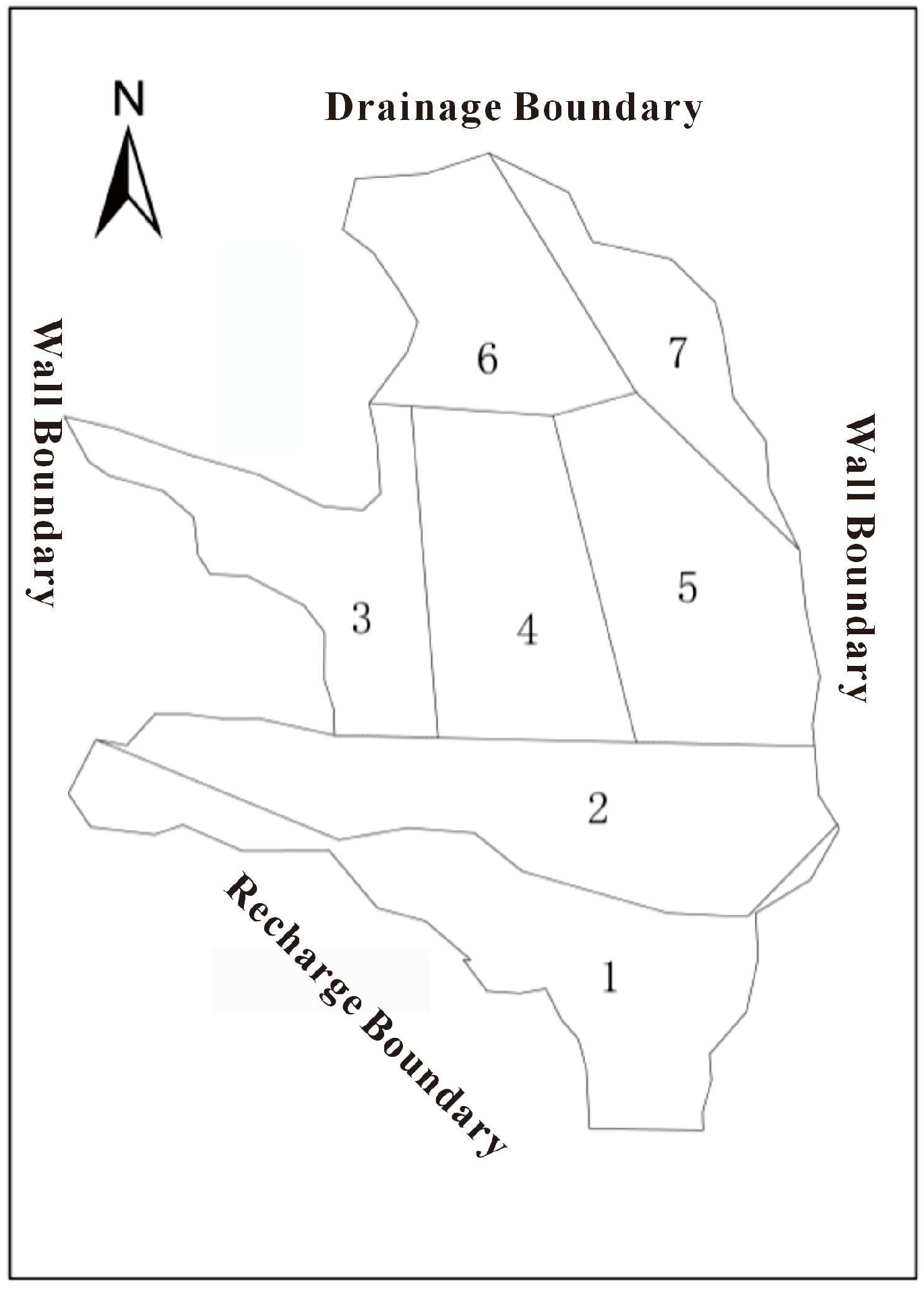

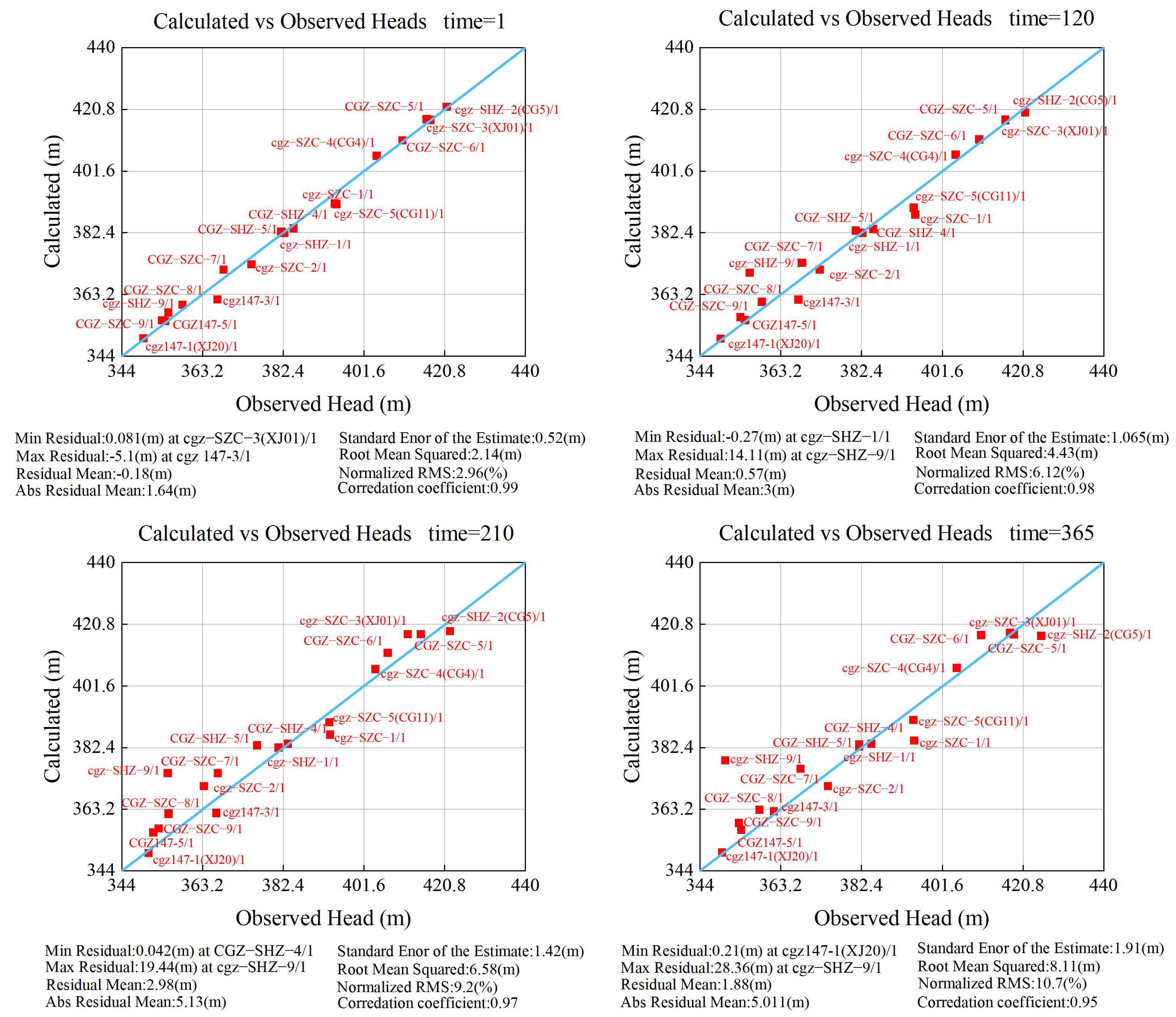
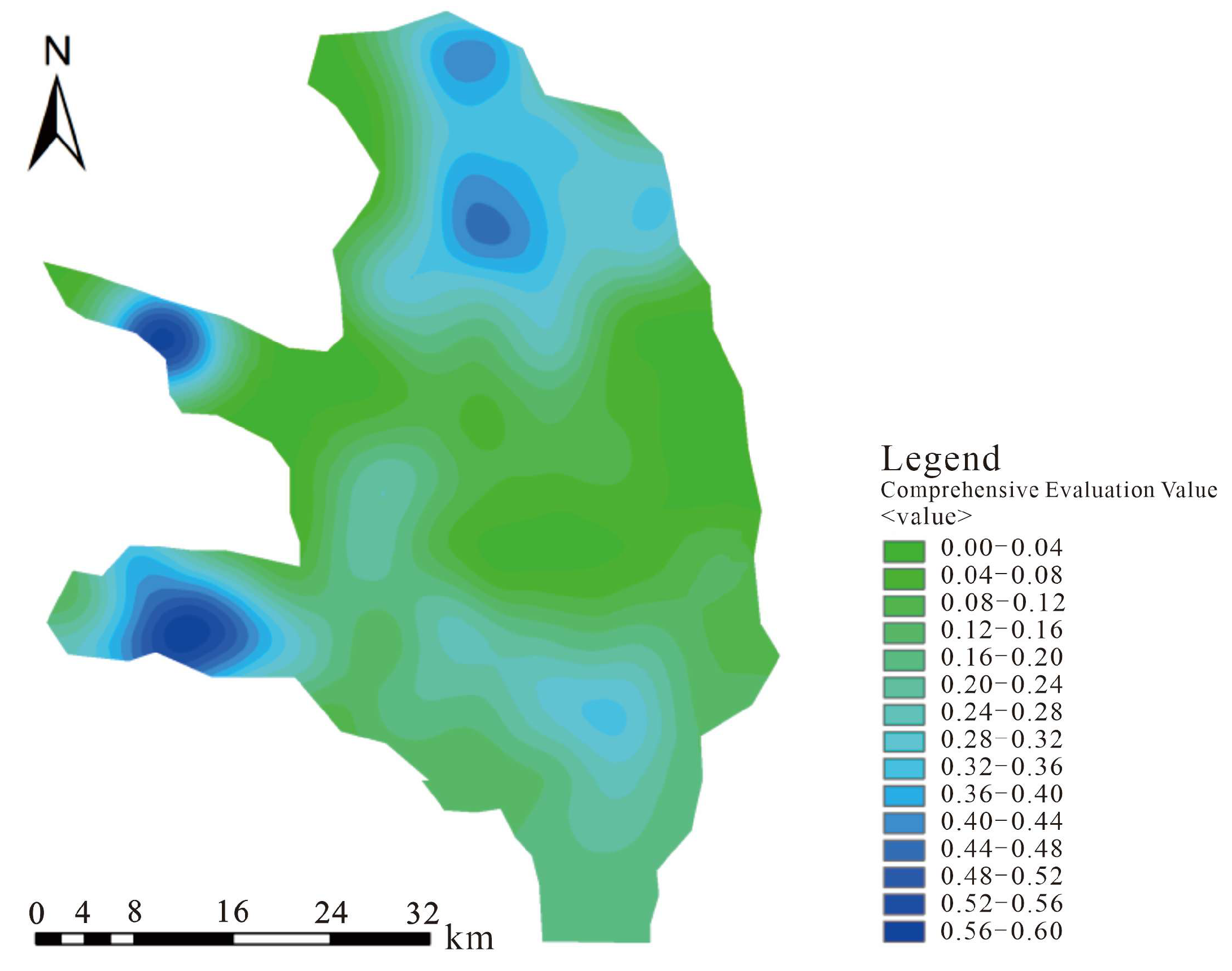
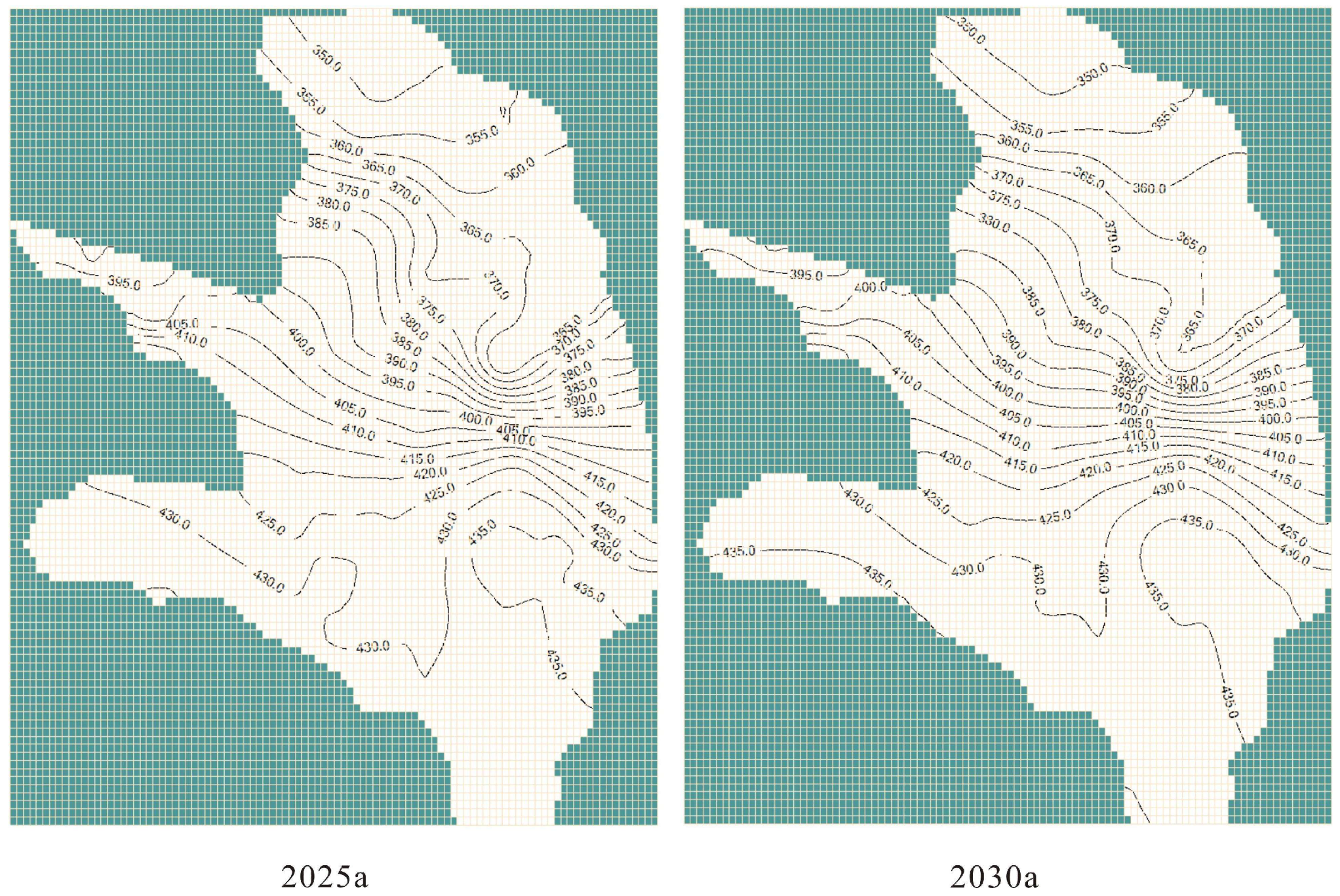

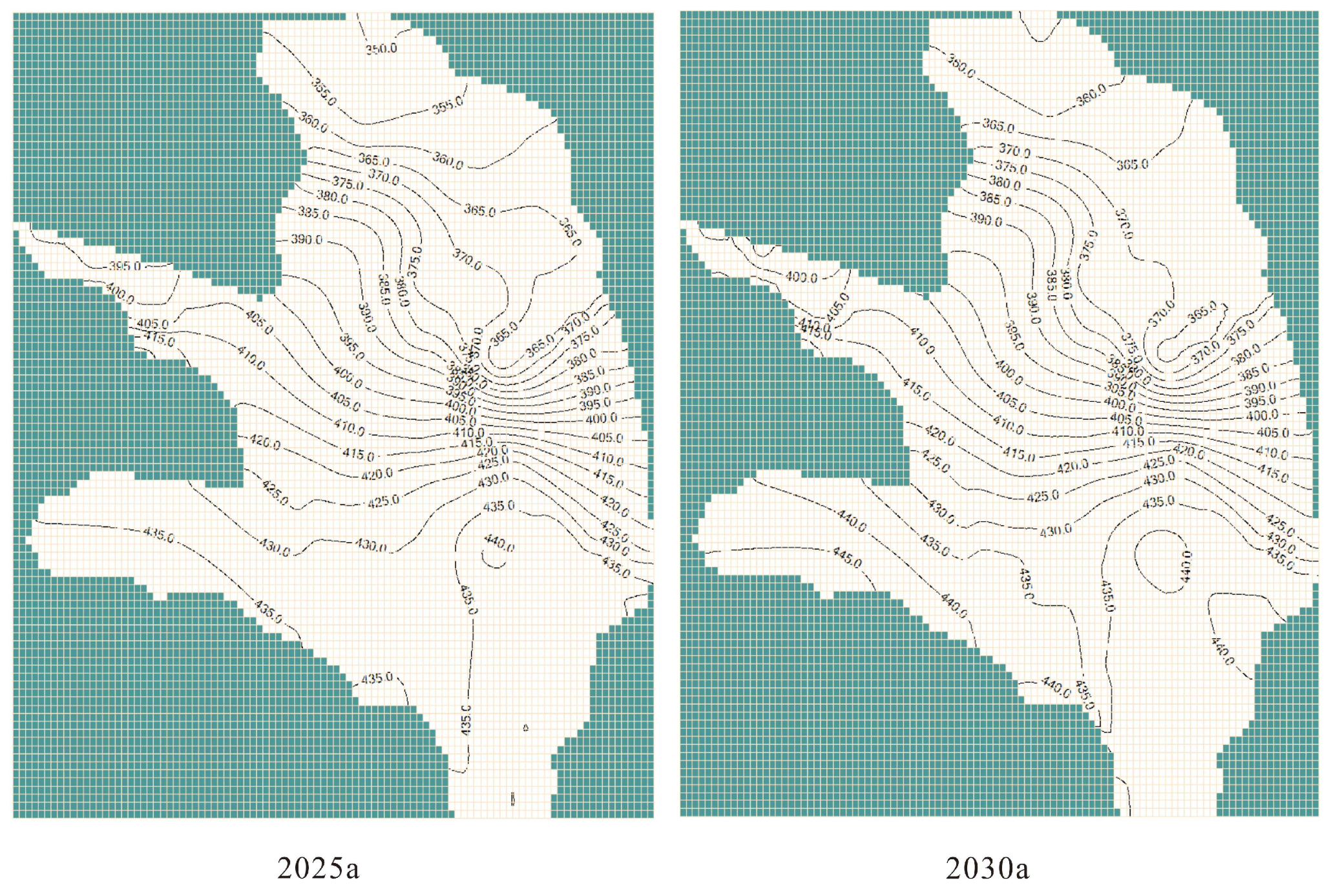

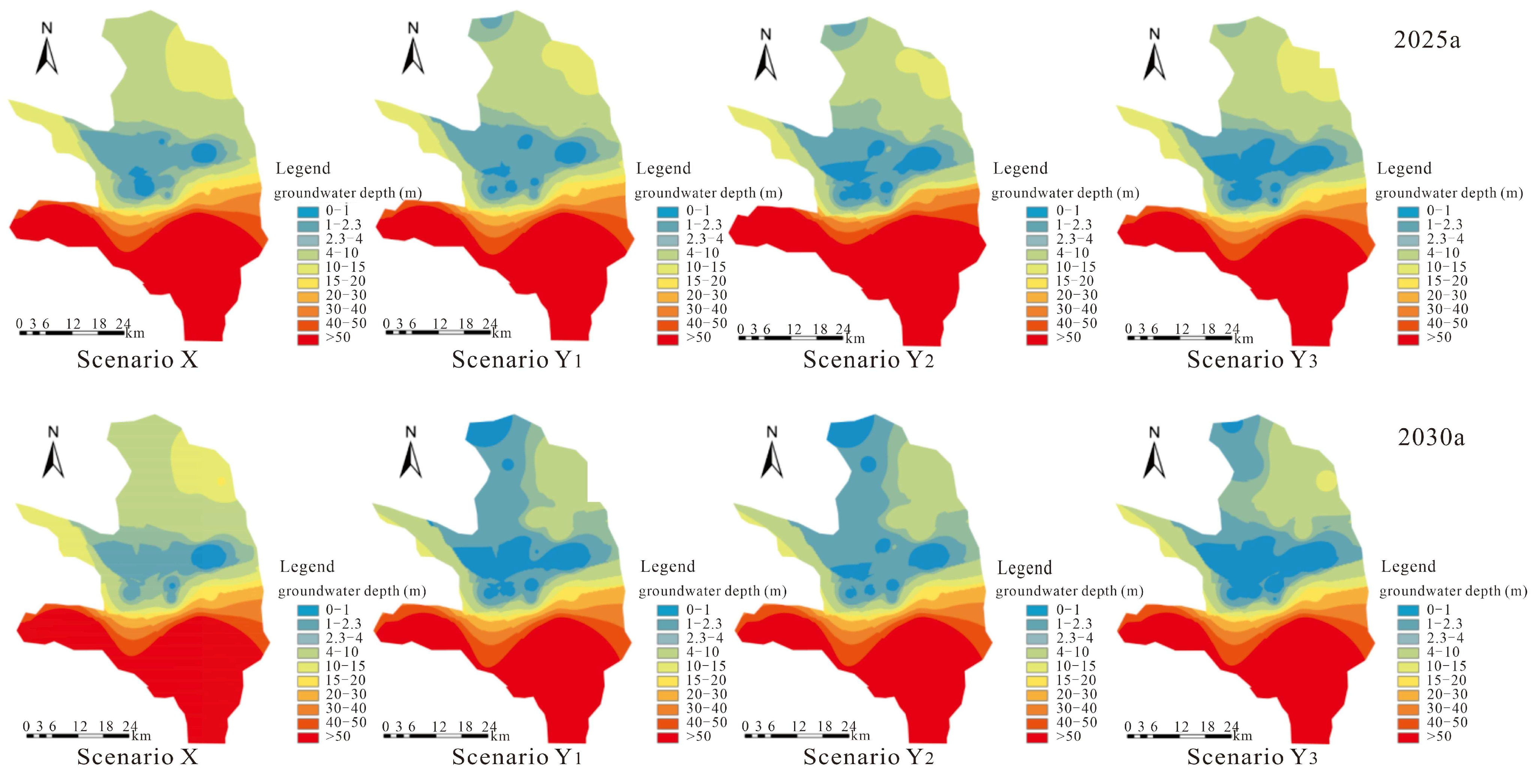
| Rock and Soil Types | Permeability Coefficient (m/d) | Specific Yield (%) |
|---|---|---|
| Gravel and pebble | 100 | 23 |
| Sand and gravel | 70 | 25 |
| Yazhong sand | 15 | 28 |
| Clay | 0.008 | 3 |
| Subclay | 0.05 | 3.5 |
| Sandstone | 80 | 16 |
| Fine sand | 3 | 25 |
| Medium-coarse sand | 40 | 28 |
| Fine sand powder | 0.8 | 8 |
| Medium-fine sand | 15 | 5.5 |
| Time (Day) | ARM (m) | SEE (m) | RMS (m) | NRMS (%) | R |
|---|---|---|---|---|---|
| 1 | 1.34 | 0.43 | 1.78 | 2.47 | 0.99 |
| 120 | 1.92 | 0.61 | 2.52 | 3.49 | 0.99 |
| 210 | 4.41 | 1.03 | 5.09 | 7.12 | 0.98 |
| 365 | 3.59 | 1.42 | 6.05 | 7.99 | 0.97 |
| Average | 2.82 | 0.87 | 3.86 | 5.27 | 0.98 |
| Time (Day) | ARM (m) | SEE (m) | RMS (m) | NRMS (%) | R |
|---|---|---|---|---|---|
| 1 | 1.64 | 0.52 | 2.14 | 2.96 | 0.99 |
| 120 | 3.00 | 1.07 | 4.43 | 6.12 | 0.98 |
| 210 | 5.13 | 1.42 | 6.58 | 9.2 | 0.97 |
| 365 | 5.01 | 1.91 | 8.11 | 10.7 | 0.95 |
| Average | 3.70 | 1.23 | 6.32 | 7.25 | 0.97 |
| Appraisal of Value (z) | Number of Wells | Y1 | Y2 | Y3 | |||
|---|---|---|---|---|---|---|---|
| Reduction Ratio (%) | Reduction in Water (108 m3) | Reduction Ratio (%) | Reduction in Water (108 m3) | Reduction Ratio (%) | Reduction in Water (108 m3) | ||
| >0.52 | 57 | 100 | 0.047 | 100 | 0.052 | 0.22 | 0.015 |
| 0.48–0.52 | 42 | 80 | 0.028 | 85 | 0.033 | 0.22 | 0.011 |
| 0.40–0.48 | 162 | 60 | 0.081 | 70 | 0.104 | 0.22 | 0.043 |
| 0.32–0.40 | 280 | 40 | 0.093 | 55 | 0.141 | 0.22 | 0.074 |
| 0.2–0.32 | 490 | 20 | 0.081 | – | – | 0.22 | 0.130 |
| <0.2 | 213 | – | – | – | – | 0.22 | 0.056 |
| Total | 1244 | 0.22 | 0.329 | 0.22 | 0.329 | 0.22 | 0.329 |
| Appraisal of Value (z) | Number of Wells | Y1 | Y2 | Y3 | |||
|---|---|---|---|---|---|---|---|
| Reduction Ratio (%) | Reduction in Water (108 m3) | Reduction Ratio (%) | Reduction in Water (108 m3) | Reduction Ratio (%) | Reduction in Water (108 m3) | ||
| >0.52 | 57 | 100 | 0.069 | 100 | 0.076 | 0.32 | 0.022 |
| 0.48–0.52 | 42 | 80 | 0.041 | 85 | 0.048 | 0.32 | 0.016 |
| 0.40–0.48 | 162 | 60 | 0.118 | 70 | 0.152 | 0.32 | 0.063 |
| 0.32–0.40 | 280 | 40 | 0.135 | 55 | 0.206 | 0.32 | 0.108 |
| 0.2–0.32 | 490 | 20 | 0.119 | – | – | 0.32 | 0.190 |
| <0.2 | 213 | – | – | – | – | 0.32 | 0.083 |
| Total | 1244 | 0.32 | 0.482 | 0.32 | 0.482 | 0.32 | 0.482 |
| Silt Loam | Degree of Mineralization (g·L−1) | |
|---|---|---|
| <5 | 5–15 | |
| Capillary rise height (m) | 1.3 | 1.6 |
Disclaimer/Publisher’s Note: The statements, opinions and data contained in all publications are solely those of the individual author(s) and contributor(s) and not of MDPI and/or the editor(s). MDPI and/or the editor(s) disclaim responsibility for any injury to people or property resulting from any ideas, methods, instructions or products referred to in the content. |
© 2025 by the authors. Licensee MDPI, Basel, Switzerland. This article is an open access article distributed under the terms and conditions of the Creative Commons Attribution (CC BY) license (https://creativecommons.org/licenses/by/4.0/).
Share and Cite
Zhang, J.; Xia, Y.; Li, X.; Zhang, Y.; Li, Q.; Wang, W.; Yang, G. Numerical Simulation of Groundwater Regulation in Arid Oasis Regions: A Case Study of the Shihezi Irrigation District, Xinjiang. Water 2025, 17, 3232. https://doi.org/10.3390/w17223232
Zhang J, Xia Y, Li X, Zhang Y, Li Q, Wang W, Yang G. Numerical Simulation of Groundwater Regulation in Arid Oasis Regions: A Case Study of the Shihezi Irrigation District, Xinjiang. Water. 2025; 17(22):3232. https://doi.org/10.3390/w17223232
Chicago/Turabian StyleZhang, Jun, Yingli Xia, Xiaolong Li, Yongwei Zhang, Qinglin Li, Wenzan Wang, and Guang Yang. 2025. "Numerical Simulation of Groundwater Regulation in Arid Oasis Regions: A Case Study of the Shihezi Irrigation District, Xinjiang" Water 17, no. 22: 3232. https://doi.org/10.3390/w17223232
APA StyleZhang, J., Xia, Y., Li, X., Zhang, Y., Li, Q., Wang, W., & Yang, G. (2025). Numerical Simulation of Groundwater Regulation in Arid Oasis Regions: A Case Study of the Shihezi Irrigation District, Xinjiang. Water, 17(22), 3232. https://doi.org/10.3390/w17223232







